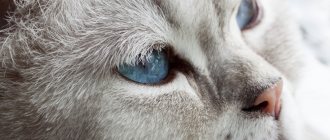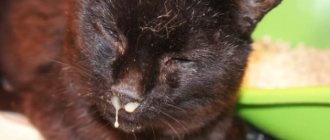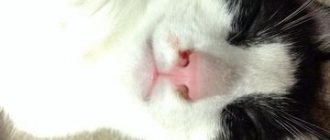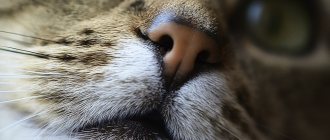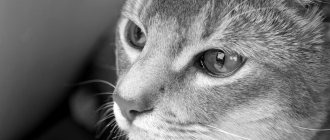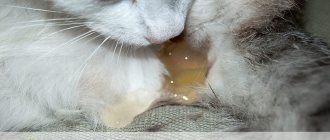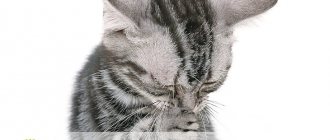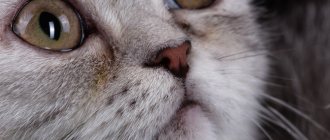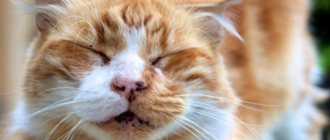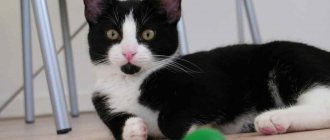The occurrence of rhinitis, or in other words, a runny nose, provokes the process of sneezing in cats. Unlike humans, this is the only way for an animal to get rid of mucous secretions accumulated in the nasal passages. The discharge has its own characteristic features depending on the reason that provoked the increased secretion production by the glands.
In addition, the discharge can be not only transparent, but also purulent, greenish or yellow, mixed with blood and an unpleasant odor.
There are many reasons for the appearance of discharge from the nasal passages, so the owner’s task is to promptly pay attention to the development of the pathological condition and take elimination measures. This means you need to consult a veterinarian without self-medicating. After diagnosis and prescribed treatment, strictly follow the doctor’s instructions.
Prevention
Measures to prevent the appearance of clear fluid from the nose:
- Water procedures. Hydromassage of the sinuses helps remove accumulated mucus.
- Rinsing the nose with a saline solution prepared at home or using pharmacy sprays “Quix”, “Aqualor”.
- Blowing your nose is a procedure for cleansing the nasal cavity.
- Humidifying the air in the room will protect the nasal mucosa from drying out and swelling.
- Diet therapy - avoidance of spicy foods, seasonings, and whole milk.
- Lubricating the nasal mucosa with “Oxolinic ointment” before each exit during the flu epidemic.
- Rinse your mouth and rinse your nose after every return home.
- Elimination of hypothermia and drafts.
- Multivitamins.
Causes
Transparent nasal discharge is a reflex reaction of the body to cleanse itself of the following irritants:
- Infectious – viruses, pathogenic bacteria, helminth larvae.
- Non-infectious - foreign objects and allergens.
If fluid comes out of one nostril, it means a mechanical object has entered it. In case of an allergic irritant, both nasal openings remove dust or block access to the mucous membrane of unpleasant-smelling substances - perfumes, gasoline, tobacco. If you remove the object or interrupt the contact of the cat's nose with the irritant, the discharge will stop.
Rhinitis
Otherwise, pay attention to additional signs. They indicate a contagious disease.
If, in addition to nasal discharge, lacrimation or conjunctival hyperemia occurs, contact a specialist. The probable cause of the pathology is cat flu. Unvaccinated young animals, elderly individuals or those weakened by chronic illnesses suffer.
Signs of rhinotracheitis in cats
Symptoms of rhinotracheitis appear gradually. On average, the incubation period ranges from 3 to 8 days. Often, sick animals experience an increase in temperature up to 40°C (we remind you that a cat’s normal body temperature varies from 37.5 to 39°C).
Rhinotracheitis in cats occurs in acute or chronic form. In the second case, prolonged remission alternates with bouts of relapse. 80% of animals after recovery are carriers of the virus.
The main signs of rhinotracheitis in cats:
- purulent discharge from the eyes and nose,
- conjunctivitis,
- inflammation of the nasal mucosa,
- cough,
- small ulcers on the tongue,
- profuse drooling,
- dyspnea,
- deterioration or complete loss of appetite,
- weight loss,
- general weakness,
- sluggish, apathetic state.
Do you suspect your cat has rhinotracheitis? Do not hesitate - go to a veterinary clinic and get examined. If you seek help in a timely manner and receive effective treatment, your pet’s recovery will take about 8-10 days.
Inflammatory diseases
Lymphoplasmacytic rhinitis (LP rhinitis) is the most common inflammatory disease of the nasal cavity in cats. This type most often occurs in middle-aged and older cats, but it can also occur in young animals. It is not known why some cats suffer from this type of inflammatory disease and others do not. When examined with modern imaging techniques (such as CT or MRI), diseases of the nasal cavity of this type usually do not show destruction of the turbinates (tiny bony curls inside the nose). Sometimes CT, MRI and rhinoscopy show thickening (hyperplasia) of tissue. Rhinoscopy may show other changes, such as redness (flushing). To make a definitive diagnosis of this disease, tissue from the nasal cavity must be sent for histological examination (examination under a microscope by a histologist).
Steroid medications, such as prednisolone or prednisone, can be used to reduce inflammation in the nasal cavity. First, we prescribe these drugs in high doses for a short time to reduce inflammation. If the cat shows signs of improvement, we slowly reduce the dose as much as possible to control the symptoms. The exact dose reduction schedule depends on your cat's condition, but in general, if the condition improves, we usually reduce the dose by 25% every 2-3 weeks. In some cases, it is possible to stop taking steroids completely. Some cats require a long course of low dose steroids. If this is your case, we will try to keep your dose to the minimum required to control your symptoms.
Steroids have several side effects. At high doses, thirst and urination increase. It is very important that the animal always has enough water. A high dose will likely increase your cat's appetite, but you should not feed her more than usual. In rare cases, steroids cause gastrointestinal ulcers, which may be accompanied by vomiting, diarrhea, decreased appetite, blood in the stool, or black, tarry stool. If you notice any of these symptoms, be sure to tell your veterinarian. Steroid medications should not be stopped abruptly as this can lead to a life-threatening reaction (Addisonian crisis), and therefore changes in the dosage of these medications should only be done under the supervision of a veterinarian.
Allergic rhinitis . Cats can suffer from allergic rhinitis, but it is less common in them than in humans. With CT/MRI and rhinoscopy, the picture may be similar to lymphocytic-plasmacytic rhinitis, and a final diagnosis requires a biopsy with histological examination (examination of a tissue fragment under a microscope, carried out by a histologist). In allergic rhinitis, different types of inflammatory cells are visible under the microscope than in lymphocytic-plasmacytic rhinitis. If your pet has allergic rhinitis, we recommend trying environmental control measures similar to those for people with allergies (using air purifiers, avoiding allergy triggers). It is possible to prescribe specific medications depending on the patient.
How to treat rhinotracheitis in cats?
The treatment regimen depends on the severity of the disease. For mild rhinotracheitis, therapy is not required. It is enough to clean the animal’s nose and eyes from the resulting crusts using a cotton pad previously soaked in saline solution. If the cat’s appetite has worsened, the veterinarian will select a more nutritious and balanced diet. At this stage, it is extremely important to monitor the condition of the animal.
For severe rhinotracheitis, the veterinarian prescribes medications. They are selected individually, depending on the symptoms of the disease and the condition of the animal. The following drugs are usually prescribed:
- Antibiotics . They are recommended by a veterinarian if rhinotracheitis is accompanied by a secondary infectious disease or when concomitant infections occurring simultaneously with it are identified;
- Interferon-based products . For recurrent rhinotracheitis, such drugs are used locally - they need to be instilled several times a day into both eyes and nasal passages to prevent further development of the disease;
- Immunomodulators . They increase the animal’s body’s resistance to various diseases and strengthen cellular immunity. Additionally, immunomodulators produce antibodies against the pathogen;
- Sulfonamide drugs . They are synthetic antimicrobial agents prescribed to prevent the growth of bacteria and chlamydia. Such drugs have chemotherapeutic activity against a number of infections;
- Vitamin and mineral complexes . They are intended to restore the animal’s body and prevent the development of secondary infections. After the examination, the veterinarian will recommend which vitamin and mineral complexes are best for your pet.
In order for your cat to quickly cope with rhinotracheitis, follow all the veterinarian’s recommendations and do not self-medicate - do not risk the health of your beloved pet!
Symptomatic treatment
If nasal discharge interferes with the animal’s full life, increases and changes in composition, then the cat must be shown to a doctor.
The veterinarian will assess the animal's condition. To make a more accurate diagnosis, the specialist will assess the cat’s general condition and well-being. He will also appreciate:
- the nature of the discharge (when it is more frequent, when, on the contrary, there is practically no discharge, whether the intensity of the discharge is affected by the activity of the animal, in what position of the body the flow from the nose is especially strong);
- abundance of discharge;
- does the discharge dry out and form crusts, or does the nose remain wet most of the time;
- is there snoring, sniffling, how much does the cat’s discharge bother him?
- where the discharge is localized: in both nostrils or only in one;
- Does the cat breathe through its nose while sleeping?
- how much the animal’s behavior changed when a runny nose appeared.
In accordance with the diagnosis, the specialist will prescribe treatment. It is important not to self-medicate and follow the doctor’s recommendations. It is also necessary to properly care for the animal’s sore nose, clean it of mucus, pus and crusts as carefully as possible so as not to damage the nasal passages.
So, in case of allergic reactions, it is not necessary to clean your nose of clear mucus. Veterinarians prescribe antihistamines, but they will only be effective if the allergen has been eliminated.
For rhinitis, the nose is washed with a 1% zinc sulfate solution or saline solution. You can warm your nose with bags of cereal heated in a frying pan.
For infections, it is important to correctly identify the pathogen and select the appropriate antibacterial, antiviral or antifungal drug. As a rule, relief occurs after 2-3 uses of the medicine.
If the animal’s nose is stuffy and it’s hard for him to breathe, then vasoconstrictor drops are used. But you should not abuse them - such drops are addictive. Drops are selected in children's dosage.
For tumors and polyps, doctors consider surgery. It is important to assess the depth of the tumor, the general condition of the animal, and concomitant diseases.
But it is worth remembering that if a foreign body gets into the cat’s nose, you cannot remove it yourself using cotton swabs or tweezers. This can push the object even deeper into the nostril and injure the mucous membrane!
Symptoms of rhinitis in cats
There are signs that will tell you that your furry pet is suffering from rhinitis. These include:
- Difficulty breathing. After active actions, running or playing, the animal's breathing becomes heavy. Swollen nasal passages do not allow sufficient oxygen to be received; the cat gasps for air.
- A state of detachment, indifference to everything around. The animal falls into apathy; games, entertainment and treats do not interest him.
- The cat is trying to put its nose in order on its own, scratching the diseased organ with its paw, moving it over furniture and other objects.
- The temperature may rise (up to 39 C), the cat’s nose becomes hot.
- Often a runny nose is accompanied by conjunctivitis, the cat's eyes swell, and pus collects in the corners.
- Nasal discharge.
The types of rhinitis vary, as does nasal discharge. The acute form of a runny nose is characterized by copious clear discharge. When a cat sneezes frequently and endlessly rubs its nose on furniture and other objects, there is reason to think about allergic rhinitis. If the cause of a runny nose is a viral infection, the discharge from the animal's nose will be the color of pus.
When rhinitis is caused by damage to the inner lining of the nose, the discharge is bloody and flows from only one nostril. With any type of rhinitis, crusts of dried discharge are visible under the animal’s nose.
Treatment of runny nose in cats
If you notice snot in a cat, you should watch your pet. Many serious pathologies, one of the manifestations of which is a runny nose, are accompanied by other unpleasant symptoms - the owner will have to talk about them during a visit to the doctor. Only a specialist can find out the cause of rhinitis.
Self-therapy is fraught with negative consequences - the use of certain drugs can hide the symptom of a serious pathology, and time will be lost, because most diseases are successfully treated if detected at an early stage.
Traditional methods of treating a runny nose
If the animal’s behavior has not changed - it is playful and does not refuse food, then before visiting the veterinarian you can relieve a runny nose using folk methods:
- inhalation with eucalyptus: an infusion of 15 g of herb and 200 ml of boiling water is used - it is prepared within 30 minutes; for inhalation, you can use a teapot; before the procedure, the pet should be wrapped in a towel and sat down so that the spout of the teapot is in close proximity to the animal’s face, and care must be taken to ensure that the pet does not get burned;
- applying a bag of warm sand or salt: the procedure may be accompanied by copious discharge, which must be removed with a previously prepared disc or cotton swab;
- rinsing with saline solution: the liquid is injected carefully using a syringe without a needle - 0.5 ml is enough for each nostril; Before starting manipulations, the animal must be wrapped in a diaper or piece of cloth.
Video: treating a kitten for a runny nose with folk remedies
Treatment of a runny nose in a cat with medications
After determining the cause of a runny nose in a pet, a specialist will prescribe appropriate therapy. If a runny nose is one of the signs of an infectious disease, then you cannot do without an antibiotic. Frequently prescribed drugs in this group include Amoxiclav and Baytril. For mycoplasmosis and chlamydia, tetracycline drugs are prescribed, and for bordetellosis, Ciprofloxacin is indicated. Neotim, Vitafel, Giscan are used in the treatment of viral infections. The duration of treatment and dosage of drugs is determined by a specialist.
Drops are used to relieve congestion. Special products for animals, sold in veterinary pharmacies, not only relieve congestion, but also have an immunomodulatory effect. These include:
- Anandin - dosage - 2-3 drops in each nasal passage, up to three times a day;
- Maxidin - dosage - 1-2 drops in each nasal passage, 2-3 times a day;
Drops for cats relieve nasal congestion
- Thymogen - 1-2 drops in each nasal passage, once a day, is enough.
To ease breathing in cats, you can use children's Naphthyzin with Dioxidin in a 1:1 ratio - 1-2 drops in each nasal passage. Before instilling drops, remove crusts near the nose. To do this, they need to be softened with Vaseline oil.
You need to be careful when dripping into your cat's nose.
If the nature of nasal discharge is allergic, therapy with antihistamines will be required. The most effective and harmless anti-allergy drugs are Zyrtec and Fexofenadine.
It is better to entrust the removal of a foreign body from the nasal passage to a veterinarian. Manipulations are carried out under local anesthesia; in particularly severe cases, surgery is necessary. Surgical intervention cannot be avoided even in the presence of polyps.
Features of kitten therapy
Treatment of small pets is practically no different from treatment of adult animals. For furry babies, the specialist prescribes medications approved for use in kittens. To ease breathing, the following can be used: Aquamaris, children's Pinosol, Protargol, inhalations. There are no contraindications for Anandin drops either. Antibiotics acceptable for use in small pets include Vilprafen.
Nasal congestion: how to help your cat
A method to help a cat breathe better, also used by us humans, is to use water vapor to help remove mucus.
Obviously, you should not place your cat's head on a bowl of hot water, as the cat may get burned or scalded if it hits the basin. But it would be enough to prepare a steam bath by turning on the hot water of the shower and allowing the cat to enter the steamy environment for 10 minutes, keeping it away from the water.
Additionally, although the cat's nose is blocked, it is necessary to clear it by soaking a cotton swab and running it under the cat's nose. Finally, you need to contact your veterinarian, who will decide whether to subject your furry friend to antibacterial therapy or prescribe a mucolytic drug.
Watery discharge from the nasal passages
One of the most common types of nasal discharge is watery nasal discharge. And they are not always a sign of pathological conditions:
- The discharge of “water” from the nose may be the body’s reaction to heat, stuffiness and too dry air.
- In addition, a “waterfall” from the nasal passages often occurs when there is too much dust, pollen, smoke, etc. in the air in the room. This is how the body tries to prevent large amounts of debris from entering the upper respiratory tract.
But still, in many cases, constant discharge that increases over time is a serous exudate that appears in the first stages of the inflammatory process and/or allergies. Subsequently, it can “mutate”, turning into catarrhal (mucous) or purulent exudate. The main reason for its appearance is viral and bacterial infections of various etiologies.
Treatment
Treatment always depends on the root cause of the discharge, but the general recommendations in all cases are quite standard:
- To prevent the constantly flowing exudate from contributing to maceration (softening) of the skin around the nose, it is lubricated with something like oxolinic or tetracycline ointment.
- We recommend that hair that is too long (especially if the pet is particularly shaggy) be cut off in advance. This will greatly facilitate the treatment process.
- As a rule, serous rhinitis (but not always the reasons that caused it) can be treated with medicinal drops like Anandin or Fosprenil.
- If the discharge is a consequence of an allergy, the animal is given ½ tablet of diphenhydramine per day, but no more than three days in a row. In cases where it is not possible to stop the allergic reaction within this period, it is necessary to contact a veterinarian.
Symptoms of the disease
With rhinitis, the nasal mucosa in kittens becomes inflamed and characteristic discharge appears. They can be unilateral or bilateral, purulent or mucous, have an unpleasant odor or contain particles of blood. All this depends on the cause of the disease and its neglect.
Doctors have identified symptoms that can be observed in cats during rhinitis:
- difficult and intermittent breathing;
— it is difficult for a pet to play active games;
- fatigue, drowsiness, apathy;
- loss of appetite;
- itching in the nose area, constant desire to scratch it, rub it;
— the cat begins to sneeze;
- cough appears;
- nose is dry and hot (fever);
- pus from the eyes (the eyes themselves become slightly swollen);
- mucus from the nose.
The most dangerous manifestation of rhinitis is purulent discharge from the animal’s nose, which indicates an advanced stage of the disease. But you shouldn’t think that only with purulent discharge you should see a doctor. Any of the above symptoms is a reason to take action.
Causes of nasal discharge
Of course, not all nasal discharge is dangerous. Often they are a response to irritants from the environment, a protective reaction of the body.
Discharge from an animal's nose can be:
- mucous;
- serous;
- mucopurulent;
- purulent;
- bloody;
- purulent-bloody.
Mucous discharge is a clear discharge, quite liquid (not too viscous). Such discharge may be a sign of an allergy and the entry of a fine substance into the animal’s nose, causing mechanical irritation of the mucous membrane. The secretion of the mucous membrane may contain leukocytes and microparticles that cause irritation.
If the discharge has changed consistency, completely blocking the animal’s nasal passages, or its color has changed, becoming yellow or yellow-green, this is an alarming sign and it’s time to rush to the veterinarian. Yellow-green discharge is most often a sign of bacteria penetrating the cat’s nasal mucosa. In this case, the secretion contains a large number of pathogenic microorganisms. Yellow secretion is a sign of a viral infection.
If there is a lot of discharge and it prevents the animal from breathing fully, then a visit to the doctor should happen as quickly as possible.
Pus in a cat's nasal discharge is never a sign of a minor illness. If a thick yellow secretion appears, your pet must be shown to a doctor.
Bloody and purulent-bloody discharge indicates the seriousness of the pathology. There are many reasons for such discharge, and only a veterinarian can determine the exact one.
The causes of nasal discharge in cats are varied. These include injuries with subsequent damage to the mucous membrane by pathogenic bacteria, and viral diseases (pandeikopenia, rhinotracheitis, calcevirosis), and an allergic reaction, and chlamydial pneumonia, and parasitic diseases (toxoplasmosis).
Let's look at them in more detail:
- Transparent discharge flowing from one nostril may be a sign of a foreign object entering the nasal passage. If the object is large or sharp, the discharge may be mixed with blood; if the object is in the sinus for a long time, a bacterial infection may occur. The general condition of the pet is slightly impaired.
- Allergic rhinitis is accompanied by frequent sneezing of the animal and the discharge of clear mucous discharge, often in large quantities. At the same time, you can also observe discharge from the cat’s eyes, often even more intense than from the nose.
- Reaction to external stimuli. A curious cat may stick its face into bags and boxes of household chemicals that have a strong odor. In this case, the reaction will resemble an allergy, but with the difference that the discharge will go away as soon as all the irritating elements are eliminated from the nose due to mucus and sneezing.
- Entry of foreign objects. You can tell that something has gotten into your cat's nose by the sudden appearance of discharge from one nostril, sniffling or lack of air movements in the nostril, or wheezing in the nostril. Also, the cat will constantly rub its nose; from its behavior it is easy to guess that something is bothering it.
- Parasites. Nasal discharge is caused by mites, helminths and fleas crawling into the nasal cavity. Treatment should be both local and internal (for worms). In this case, the nature of the discharge is similar to an allergic reaction.
- Infection with fungi (most often cryptococcosis), brain tumors that collapse or grow into the nose, and chronic infections caused by bacteria cause the destruction of nasal membranes. This leads to the flow of mucopurulent secretion mixed with blood from one or both nasal passages. If blood appears in a cat's nasal secretions, a mandatory consultation with a veterinarian is necessary. Additional symptoms in a cat may be: enlarged lymph nodes, swelling in the nose, damage to the nasopharynx and others.
- In young kittens, pus in the nasal secretions can appear due to poor care, the absence of a mother, and significant dietary errors. Also in this case, purulent discharge from the eyes is observed.
- Bloody discharge from the animal's nose can accompany arterial hypertension. In addition to nosebleeds, the cat may have noticeable behavioral disturbances, a “drunk” gait, and irritability.
- Mechanical trauma can also cause nosebleeds.
- A severe respiratory disease in cats caused by a herpes virus is called rhinotracheitis. It is accompanied by many symptoms: general (lethargy, fatigue, drowsiness, refusal to eat) and specific (purulent discharge from the eyes and nose, sneezing). Pneumonia may develop in weakened animals, and self-abortion may occur in pregnant cats.
- Another common infectious disease that is dangerous for cats is calcivirus. It is characterized by copious discharge from the nose and eyes, initially mucous, then serous, then purulent, foul-smelling discharge. The cat begins to develop hypersalivation, fever (up to 40.5°C), and ulcerations appear on the mucous membranes of the mouth, lips, and tongue. The animal refuses food, diarrhea may develop, followed by constipation.
- “Feline distemper” or panleukopenia is another terrible disease of cats. The heart, respiratory system, and gastrointestinal tract are affected. The cat suffers from severe intoxication and dehydration. The disease occurs with a high temperature of up to 41°C, yellow-green vomiting, diarrhea, conjunctivitis, and rhinitis. Animals often stand over a bowl of water, but do not drink due to severe abdominal pain.
- Rhinitis can also cause congenital nasal defects. Some breeds of cats may have discharge from the nose and eyes not related to the disease, but related to the anatomy of the animal, for example, Persian extreme cats.
- Some parasitic diseases cause rhinitis (toxoplasmosis).
It is worth noting that occasional nasal discharge in a cat, which generally does not change its well-being, is normal. They are necessary for natural cleansing of the nasal mucosa from dust.
Treatment method and prognosis
It is important to understand that a kitten’s runny nose will not go away without treatment. If left untreated or treated without clinical examination, the pet will die.
Depending on the test results, the doctor selects the necessary medications, nasal drops, or prescribes complex treatment, including antiviral, antibacterial agents and supportive therapy.
If you contact a specialist in a timely manner, the prognosis for recovery is favorable, but it does not always take a short time.
So, if an animal is identified as infectious, treatment may take several months.
Preventing runny nose in pets
To eliminate most causes of runny nose in cats, you need to:
- limit your pet’s contact with stray animals;
- exclude access to potential allergens;
- provide the animal with a warm, dry resting place without drafts;
- do not neglect vaccination and deworming;
- support your pet’s immunity and take care of its proper nutrition.
It is quite possible to cure a runny nose in a cat on your own, but only after mandatory consultation with a doctor. If treated promptly, a specialist can identify the cause of an animal’s nasal discharge and prescribe appropriate therapy. A caring and responsible owner should closely monitor any changes in the animal’s behavior - therapy for pathology identified at an early stage will be simple and most effective.
